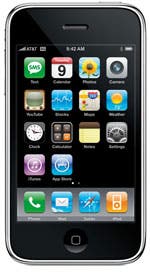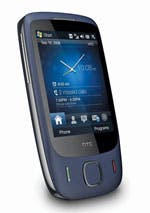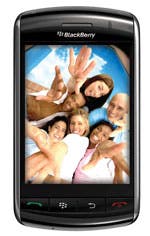 When Steve Jobs first announced the iPhone almost two years ago, he stressed the new phone’s flexibility and said that its lack of hardware buttons meant the device had a greater ability to adapt to the specific needs of an application at a given moment. As he put it, the problem with other smartphones is that they have control buttons that are fixed in plastic. Every app wants a different button. You can’t add new buttons.
When Steve Jobs first announced the iPhone almost two years ago, he stressed the new phone’s flexibility and said that its lack of hardware buttons meant the device had a greater ability to adapt to the specific needs of an application at a given moment. As he put it, the problem with other smartphones is that they have control buttons that are fixed in plastic. Every app wants a different button. You can’t add new buttons.
The decision to make the iPhone and iPod Touch touchscreen-only devices freed software developers from having to write programs with features linked to a specific button. Instead, they could create as many or as few software buttons as they needed and place them where they wanted them on the touch screen.

The decision also made it easier for Apple to make major improvements to the firmware built into the devices. Nowhere is this more evident than in the improvements made to the platform with the release of the 2.0 firmware. The original iPhone running version 1.x of the firmware was locked down and the only way to add functionality to it was through Web apps. Version 2.0 of the firmware unlocked much of the device’s potential by allowing users to install third party apps. Suddenly, the flexibility of the interface became a key feature of the device. Developers could design a plethora of new applications and give them the on-screen controls they needed. They didn’t have to work around a series of fixed keys!
Turning the iPhone into a gaming device

Good examples of this are applications that turn the iPhone into a gaming device. A personal favorite of mine is Pangea’s Nanosaur 2, a 3D game that challenges you to pilot a flying dinosaur through various landscapes, collect missing eggs, and blow up a lot of stuff (Fig. 1).
Fig. 1: Nanosaur 2 has control buttons placed in ergonomically
appropriate positions on the iPhone’s touch screen.
The game is played in landscape mode and all the controls you need are placed on the screen. The game is not available for other mobile devices, but if it was—say, for the Samsung Blackjack shown on the next page—the display would be much smaller and the controls would have to be “wired” to hardware buttons below the display. The folks at Pangea would have to design the game around the existing placement of the buttons, instead of placing the buttons in the most ergonomically appropriate position for the player.

 Design flexibility is also evident within a single game. For example, in the game Asphalt4 Elite Racing the device can be held in either landscape or portrait viewing modes (Figs. 2 & 3) and the player can choose between using on-screen controls, invisible controls on the left and right sides of the screen, or the device’s built-in accelerometer. The location of the controls changes, depending on the viewing mode and whether or not the accelerometer is used.
Design flexibility is also evident within a single game. For example, in the game Asphalt4 Elite Racing the device can be held in either landscape or portrait viewing modes (Figs. 2 & 3) and the player can choose between using on-screen controls, invisible controls on the left and right sides of the screen, or the device’s built-in accelerometer. The location of the controls changes, depending on the viewing mode and whether or not the accelerometer is used.
Figs. 2 & 3: Asphalt4 Elite Racing can be played in portrait or landscape viewing modes
and players can choose between using on-screen controls (a steering wheel at the bottom
of the screen), touch screen (press the sides of the screen) or the accelerometer.
Evolution of the user interface

When the iPhone was first released the native e-mail application (Mail) only worked in portrait mode. To compose a message you had to rely on the small, two inch wide soft keyboard at the bottom of the screen. Using word prediction technology, the keyboard readjusts the size of the “tap zones” of letters, making the ones that you are most likely to type bigger and making the letters that are less likely to be typed smaller. Still, it’s relatively easy to enter the wrong letter and have to delete it.
 With the release of the iPhone 2.0 firmware, however, Mail and some other built-in and third-party apps can be used in landscape mode (Figs. 4 & 5). When you switch to landscape by rotating the device in your hand, the keyboard expands to a larger and more comfortable width of three inches. You can still use Mail in portrait mode, but if you need greater speed and accuracy, you can switch to landscape, hold the iPhone in both hands, and type away with both of your thumbs.
With the release of the iPhone 2.0 firmware, however, Mail and some other built-in and third-party apps can be used in landscape mode (Figs. 4 & 5). When you switch to landscape by rotating the device in your hand, the keyboard expands to a larger and more comfortable width of three inches. You can still use Mail in portrait mode, but if you need greater speed and accuracy, you can switch to landscape, hold the iPhone in both hands, and type away with both of your thumbs.
Figs. 4 & 5: With the release of the iPhone 2.0 software, the built-in keyboard switches from portrait
mode (left) to a more spacious horizontal mode (below) in Mail and some other apps, when you
rotate the iPhone.
Are fewer buttons better?
The success of the iPhone’s simple “no button” design is starting to influence other phone makers (Figs 6 & 7). However, the majority of devices from other manufacturers still have built-in keyboards and plenty of buttons. And while the designers of these devices certainly pay attention to ergonomics and usability issues, they have to focus on making the device easy to use for its primary purpose.
 Take, for example, the Motorola Q. It’s pretty good as a phone and e-mail device, but not so great for games. One Moto Q user posted a comment about this on MsMobiles.com.
Take, for example, the Motorola Q. It’s pretty good as a phone and e-mail device, but not so great for games. One Moto Q user posted a comment about this on MsMobiles.com.  He complained that it was awkward using the directional pad to control the game because, even though the game was played with the device in landscape viewing mode, the D-pad controls did not automatically adapt to the orientation. When he pressed what he assumed were the left and right buttons, the game reacted as if he’d pressed the up and down buttons, and vice versa. Fortunately, the game had an option to reassign the buttons to control the game properly. But it should have happened automatically. (It’s important to note that not all mobile device users are in love with the no-button approach. Blogs are full of users’ complaining about the lack of a D-Pad on the new HTC Touch HD. Many of these users complain about the lack of tactile feedback and response with on-screen D-pads, which they believe makes the control of certain games more difficult. Because of this and usability concerns associated with legacy applications, it’s probably unlikely that other mobile OS developers will switch entirely to a no-button approach.)
He complained that it was awkward using the directional pad to control the game because, even though the game was played with the device in landscape viewing mode, the D-pad controls did not automatically adapt to the orientation. When he pressed what he assumed were the left and right buttons, the game reacted as if he’d pressed the up and down buttons, and vice versa. Fortunately, the game had an option to reassign the buttons to control the game properly. But it should have happened automatically. (It’s important to note that not all mobile device users are in love with the no-button approach. Blogs are full of users’ complaining about the lack of a D-Pad on the new HTC Touch HD. Many of these users complain about the lack of tactile feedback and response with on-screen D-pads, which they believe makes the control of certain games more difficult. Because of this and usability concerns associated with legacy applications, it’s probably unlikely that other mobile OS developers will switch entirely to a no-button approach.)
Figs. 6 & 7: The fewer hardware buttons on the HTC Touch 3G (left) and
BlackBerry Storm (right) show how the iPhone’s success has influenced
smartphone design.
Another example is T-Mobile’s new Android-based smartphone, the G1. It includes a physical keyboard which slides out from behind the device and changes the viewing mode to landscape orientation. They obviously designed it to be used by holding the device with two hands and typing with your thumbs. I tried to use it with one hand (i.e., holding it and typing on the keyboard with the same hand) and found it remarkably difficult. Because of its physical design, I don’t see how the manufacturer or a third-party app could make it any easier.
Limited only by imagination
The lack of hardware buttons means that the iPhone's interface can change to meet the needs of a specific application. It also means that it’s a lot easier for Apple to fix problems and enhance the device via the release of a new version of the firmware. They’ve been releasing a new version of the firmware every few months, so the evolution of the iPhone shows no sign of slowing down any time soon.
The initial vision that Steve Jobs laid out for the iPhone, including the rejection of a physical keyboard and a variety of hardware buttons, continues to be a significant part of its success. The iPhone might best be viewed as a blank slate to be written upon by Apple and third-party developers. And creativity being what it is, the features and functionality of the iPhone and iPod Touch are only limited by human imagination.


